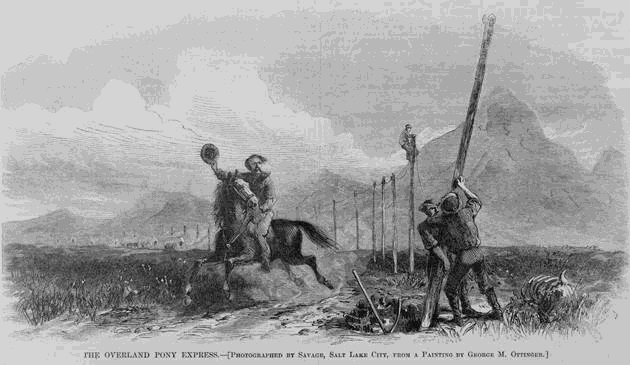Posted: September 23, 2012
Sunday, September 22, 2013 from 1-4 pm How did we get the word out before Twitter and Facebook? Before the telephone? What did people communicate and how did they get the message across long distances? Courier delivery is said to have begun with the Assyrian postal system, with credit given to Hammurabi (1700 BC) in Persia. And the Old Testament (Esther, VIII) makes mention of this system: Ahasuerus, king of Medes, used couriers for communicating his decisions. The first telegram in the United States was sent by Samuel Morse to his assistant, Alfred Vail on 11 January 1838, across two miles of wire at Speedwell Ironworks near Morristown, New Jersey. The Morse/Vail telegraph was quickly deployed in the following two decades; the overland telegraph connected the west coast of the continent to the east coast by 24 October 1861, bringing an end to the Pony Express. Western Union ceased telegraph service on January 27, 2006 after providing 145 years of service. Times change. Our youngest visitor stopped in last week and sharing information about next week’s program we asked how Mom had gotten word out about the new family member. “Facebook,” she shrugged. And of the grandfolks in the party we asked how they announced the birth of their daughter decades earlier. “Telephone,” they said without hesitating. And their parents? They might have send letters, telegrams, or formal printed announcements…it is interesting to think about what news was shared, how it was distributed and how quickly it reached its destination. The Pasto Agricultural Museum will ask visitors to image a time without cell phones and internet and explore bits and pieces of the timeline of communication this Sunday (Sept 22) from 1 to 4 pm. Try your hand at Morse code, semaphore code, or write an old fashioned letter with quill pen or old-fashioned typewriter. Several hands-on stations will be set up throughout the museum. We are partnering with the American Philatelic Society (www.stamps.org) to share some of the history of postal mail. They will also provide information about how to organize, identify, and handle stamps for collecting. Every Sunday afternoon following a Penn State Home Football game, the museum is open from 1pm to 4pm. Each Open House features a different part of our collection, with hands-on demonstrations, special exhibits, lectures, and tours. Coming up Sunday Oct 13th, we take a look at 19th century foods, recipes and cookbooks. November 3rd the focus is Fibers, partnering with local spinning and weaving guilds to bring visitors hands on spinning and weaving experience, as well as a sample of various types of fibers used today and in the past. Our final open house November 24 will feature oral history and showcase the interviews that were captured by WPSU Public Broadcasting as part of our StoryCorpsAg project this past Ag Progress Days.

The Overland Pony Express, as transcontinental telegraph lines are installed. Photographed by Savage, Salt Lake City; from a painting by George M. Ottinger. Illustration in ''Harper's'' weekly, v. 11, no. 566 (1867 Nov. 2), p. 693. Scan provided by The Library of Congress. This media file is in the public domain in the United States. This applies to U.S. works where the copyright has expired, often because its first publication occurred prior to January 1, 1923
Pasto Agricultural Museum
- Email PastoAgMuseum@psu.edu
- Office 814-863-1383
Pasto Agricultural Museum
- Email PastoAgMuseum@psu.edu
- Office 814-863-1383

